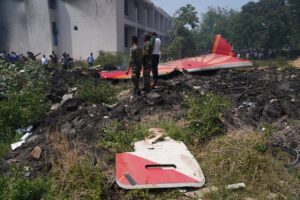On June 12, 2025, the city of Ahmedabad, India, was thrust into chaos when Air India Flight AI171, a Boeing 787-8 Dreamliner, crashed seconds after takeoff from Sardar Vallabhbhai Patel International Airport. The London-bound flight, carrying 242 passengers and crew, plummeted into a medical hostel in the Meghaninagar neighborhood, killing over 240 people in one of the deadliest aviation disasters in recent memory. As investigators probe the wreckage, questions swirl: Was the catastrophe caused by pilot error in pre-flight checks and distress signaling, or did the aircraft’s condition betray its passengers? The nation mourns, and the world demands answers.
A Routine Flight Turned Tragic
Flight AI171 departed Ahmedabad at 1:39 p.m. local time, a seemingly ordinary journey destined for London’s Gatwick Airport. The passenger manifest included 169 Indian nationals, 53 British citizens, seven Portuguese, and one Canadian, ranging from families to business travelers. The aircraft, a 12-year-old Boeing 787-8 Dreamliner with over 41,000 flight hours, was commanded by Captain Sumeet Sabharwal, an experienced pilot with 8,200 hours, and First Officer Clive Kundar, with 1,100 hours. The weather was clear, with temperatures near 38°C, and no immediate red flags were reported.

Yet, within 30 seconds of takeoff, the plane’s fate was sealed. It reached a mere 625 feet before issuing a frantic “Mayday” call to air traffic control, signaling a critical emergency. The call was abrupt, and no response followed, leaving controllers helpless as the plane vanished from radar. Videos captured by onlookers showed the aircraft struggling, its nose pitched upward but unable to climb, before it nosedived into a residential area less than a kilometer from the runway, erupting into a fireball that consumed the BJ Medical College hostel.
Devastation on the Ground
The crash site was a scene of unimaginable horror. The Boeing 787 slammed into a four-story hostel housing medical students, doctors, and their families, many of whom were eating lunch in the ground-floor canteen. The impact obliterated much of the building, with the plane’s fuel igniting a blaze that sent thick black smoke spiraling into the sky. The tail section, eerily intact, protruded from the wreckage, a grim marker of the disaster’s scale.
Emergency responders, including the Indian Army, National Disaster Response Force, and local firefighters, descended on the scene, battling flames and navigating debris to search for survivors. The hostel’s residents faced a dire situation: some jumped from upper floors, sustaining injuries but escaping death, while others were trapped in the inferno. At least 24 ground victims, including five medical students and a doctor’s spouse, were confirmed dead, with dozens more hospitalized. The total death toll, including 241 of the 242 aboard the plane, exceeded 265, with DNA identification ongoing due to the severe condition of many remains.

The sole survivor, Vishwash Kumar Ramesh, a British national seated in 11A near an emergency exit, emerged from the wreckage bloodied but alive. His survival, near the wing’s structural spar, was deemed miraculous by aviation experts, though his emotional scars—having lost his brother Ajay in the crash—run deep. Ramesh’s story has captivated the world, a flicker of hope amid overwhelming loss.
The Investigation: Pilot Error or Aircraft Failure?
As rescue efforts gave way to investigation, India’s Aircraft Accident Investigation Bureau (AAIB) took charge, supported by U.S. and British experts due to the Boeing aircraft and international passengers. One of the plane’s black boxes, the Flight Data Recorder, was recovered from the rear wreckage, offering hope for insights into the final moments. The Cockpit Voice Recorder remains missing, buried in the debris, but its recovery is critical to understanding the pilots’ actions.
Speculation centers on two potential causes: pilot error or aircraft quality. Experts suggest the pilots may have failed to properly configure the aircraft before takeoff. Video evidence indicates the landing gear remained down and flaps may not have been extended, both critical for generating lift. Such oversights could explain the plane’s inability to climb, as it reached a maximum speed of just 174 knots—far below what a Boeing 787 should achieve. The “Mayday” call, issued without follow-up, raises questions about whether the crew misjudged the situation or was overwhelmed by a sudden crisis.

Alternatively, the aircraft’s condition is under scrutiny. The Boeing 787-8, while modern, had logged significant flight hours, raising concerns about maintenance. Posts on X have fueled public skepticism, with some alleging engine issues or faulty systems, though these remain unverified. Past whistleblower claims about Boeing’s production shortcuts, particularly on the 787, have resurfaced, though no evidence directly ties these to the crash. The plane’s engines, manufactured by GE Aerospace, are also being examined, with theories of double engine failure or bird strikes proposed but not confirmed.
The investigation will scrutinize Air India’s maintenance records, pilot training, and pre-flight protocols. The airline, recently privatized under the Tata Group, has faced criticism for operational lapses in the past, though its safety record is generally strong. Boeing, already reeling from 737 MAX controversies, faces renewed pressure, with its CEO canceling a Paris Air Show appearance to address the crisis. GE Aerospace has also postponed events, signaling the gravity of the situation.
A Community in Mourning
The crash’s impact reverberates through Ahmedabad and beyond. The BJ Medical College hostel, a hub for aspiring doctors, was a place of ambition and camaraderie, now reduced to rubble. Stories of survival, like that of a student who leaped from a second-floor window, underscore the chaos, while tales of loss—families waiting at hospitals for DNA results—highlight the tragedy’s depth. The presence of Vijay Rupani, a former Gujarat chief minister, among the victims added a political dimension, amplifying calls for accountability.
Prime Minister Narendra Modi visited the crash site on June 13, consoling survivors and pledging a thorough investigation. Home Minister Amit Shah and Civil Aviation Minister Ram Mohan Naidu coordinated relief, with over 260 bodies recovered and medical aid rushed to the injured. Air India established support centers in Ahmedabad, Mumbai, Delhi, and Gatwick, offering ₹1 crore (about $116,000) per victim’s family and counseling services. The airline’s social media went dark in respect, and operations at Ahmedabad airport were suspended.
Broader Implications
The disaster has sparked debates about aviation safety in India, a rapidly growing market with increasing air traffic. The proximity of residential areas to airports, like Meghaninagar to Ahmedabad’s runway, has prompted calls for stricter zoning laws. Bird strike prevention, a potential factor, is also under review, though experts note the 787’s design should withstand such events. The crash marks the first fatal incident for the Boeing 787, a blow to its previously unblemished record and a test for Boeing’s embattled reputation.
For Air India, the tragedy is a setback in its post-privatization revival. The airline’s 2023 order of 220 Boeing aircraft, including 20 Dreamliners, underscores its reliance on the manufacturer, making the investigation’s outcome critical. Public trust, already shaken by high-profile crashes, hangs in the balance, with social media reflecting anger and fear about flying.
A Path Forward
As Ahmedabad grapples with grief, the focus remains on uncovering the truth. Was it a fatal lapse by seasoned pilots, caught in a moment of oversight, or a systemic failure in the aircraft’s design or upkeep? The black box data, once analyzed, may reveal whether Captain Sabharwal and First Officer Kundar faced an insurmountable mechanical fault or contributed to the disaster through error. For now, the wreckage tells a story of lives lost—students, travelers, crew—and a nation united in sorrow.
The sole survivor, Vishwash Kumar Ramesh, embodies both the tragedy’s cruelty and its miracles. His survival, against all odds, offers a poignant reminder of resilience. As investigators work, families mourn, and India reflects, the world watches, hoping for answers that will prevent such a catastrophe from striking again. The Air India Flight AI171 crash is a wound that will linger, but through accountability and reform, its lessons may pave the way for safer skies.


